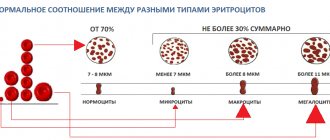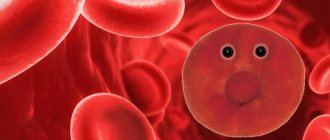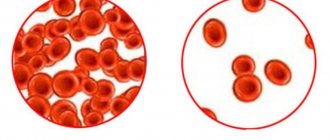The transition from intrauterine development to life in the outside world is associated with major changes in almost all organs and systems of the newborn’s body. And although these changes are inherent in nature, a certain time must pass for the baby to adapt to them - this is called transient states. There are several of them, and they develop individually in each baby. Many of these conditions have no clinical manifestations and do not cause obvious inconvenience to either the baby or his mother. But there are those that are noticeable to parents and often cause them concern. They will be discussed in this article.
Physiological weight loss
In the first few days of its life, every baby loses weight. This is a natural process that occurs because a lot of water comes out of the newborn’s body, and he has to use the reserves of nutrients received in utero. There is also relative starvation, which is associated with a deficiency of milk in the mother in the first days after childbirth. The norm is weight loss not exceeding 6-10% of the baby’s initial body weight. As a rule, by 8-10 days full-term babies and by 14 days premature babies gain the weight they had at birth.
After this, the child’s weight regularly increases. Pediatricians and parents closely monitor this indicator, as it indicates proper development.
Rapid restoration of a child's weight is facilitated by:
- early breastfeeding,
- free feeding mode,
- compliance with thermal conditions,
- prevention of hypogalactia in mother,
- rational baby care.
Uric acid infarction: symptoms, treatment in children (newborns) and adults
DlyaSerdca → Heart diseases → Heart attack → Uric acid kidney infarction: is there any cause for concern?
Uric acid renal infarction in children is a physiological condition that is not related to any pathology.
This is the process of adaptation of the body of a newborn child to extrauterine life - the transition to independent breathing and changes in metabolism.
A heart attack is one of the processes called borderline, since it occurs at the junction of intra- and extrauterine life in the first days after birth.
It occurs in approximately 30% of full-term infants in the first seven to ten days of life.
It occurs much less frequently in premature infants - approximately 10%; in very premature infants it practically does not occur.
Uric acid infarction of the kidneys has characteristic signs that immediately attract the attention of the mother or medical staff. These include:
- opaque red-brown urine, upon settling, a clearly visible, rather abundant precipitate of uric acid salts falls out;
- urine leaves colored spots on diapers or diapers, where uric acid can crystallize in the form of a fine salt;
- brown staining around the urethra;
- there is no deterioration in the health of the newborn;
- symptoms occur from the second to the fifth day of life (this is the so-called infarction period) and disappear within two to three days without treatment.
Causes
In the first days after birth, the child adapts to new conditions, while the concentration of uric acid in the urine of a newborn increases, compared to an infant - its amount is two to three times higher.
Kidney infarction
It does not have the ability to completely dissolve, since an insufficient volume of urine is still produced due to the small intake of fluid into the body and the increase in water loss through the skin and during breathing.
A small volume of urine excreted (transient oliguria) is normal for all full-term healthy babies in the first two to three days of life.
For comparison:
- in the first two days, urine output ranges from 0.5 to 2.5 ml/kg/h;
- from the third day, diuresis increases to 3-4 ml/kg/h.
The epithelium of the renal tubules produces the protein substance hyaline, which fills the lumens of the tubules, taking the shape of cylinders. From concentrated urine, uric acid and its salts (sodium and ammonium urates) are deposited in the renal tubules on a hyaline base with the formation of infarct masses.
With an increase in the amount of fluid entering the body, the dissolution of acid and urate increases, and their leaching from the tubules gives the urine a brown color. The presence of protein makes urine cloudy.
Why an increased level of uric acid is formed is not known exactly, but it is believed that this is due to the increased breakdown of leukocytes, which are found in increased numbers in the blood of a newborn.
In this case, pyrimidine and purine bases are formed, and from them ultimately uric acid.
According to observations, uric acid renal infarction most often develops in the following cases:
- late ligation of the umbilical cord;
- objectively weak baby;
- presence of jaundice in newborns.
We recommend!
Having studied Elena Malysheva’s methods in the treatment of HEART DISEASE, as well as restoration and cleansing of VESSELS, we decided to bring it to your attention...
Read more…
Diagnosis and treatment
Doesn't cause any problems. Based on the characteristic features of urine (without deterioration of the general condition) of children in the first 10 days of life.
Microscopic examination reveals hyaline cylinders in their pure form and with deposits of salt crystals, urate in the form of rods and balls. Microhematuria is often observed.
Despite the name, uric acid renal infarction in infants is not a disease; the epithelium of the renal tubules does not undergo dystrophy, the structure of the renal tissue is not affected or changed, so the child does not need treatment.
The main recommendation is to give plenty of water in addition to regular feeding to increase the formation and flow of urine.
No other action is required. Urine status usually returns to normal within 48 hours. The prognosis is favorable.
Review from our reader Victoria Mirnova
I recently read an article that talks about Monastic tea for treating heart disease. With this tea you can FOREVER cure arrhythmia, heart failure, atherosclerosis, coronary heart disease, myocardial infarction and many other diseases of the heart and blood vessels at home.
I’m not used to trusting any information, but I decided to check and ordered a bag. I noticed changes within a week: the constant pain and tingling in my heart that had tormented me before receded, and after 2 weeks disappeared completely. Try it too, and if anyone is interested, below is the link to the article.
Read the article —>
But if the urine does not return to normal within a week, the child behaves restlessly, or has a fever, then the child needs to be examined for the presence of kidney diseases.
Unlike children, for adults this condition indicates the presence of serious chronic diseases and is much more severe.
In particular, uric acid infarction is observed in gout, leukemia (especially during treatment, when there is massive death of leukemic elements), during and after treatment of pneumonic crises (caused by the disintegration of exudate and absorption of its components), the disintegration of tumors during chemotherapy, in severe purulent processes.
Note! In these cases, a heart attack is also not an independent disease, but only indicates other catabolic processes occurring in the body.
Comments:
Better read what Olga Markovich says about this. For several years I suffered from atherosclerosis, ischemic heart disease, tachycardia and angina pectoris - pain and discomfort in the heart, irregular heart rhythms, high blood pressure, shortness of breath even with the slightest physical exertion. Endless tests, visits to doctors, and pills did not solve my problems. BUT thanks to a simple recipe, constant pain and tingling in the heart, high blood pressure, shortness of breath - all this is a thing of the past. I feel great!!! Now my attending physician is surprised how this is so. Here is a link to the article.
dlyaserdca.ru
Heat imbalance
Borderline conditions in newborns also include a transient disturbance of heat balance or metabolism. The baby's body temperature may fluctuate - increase or decrease, usually slightly. This is easy to explain. Thermoregulation processes are still immature and imperfect, very sensitive to environmental changes. A child's heat balance depends on any fluctuations in indoor or outdoor temperature.
Therefore, it is extremely important to ensure a suitable temperature in the room (20-220C for full-term babies, 23-240C for premature babies), protect them from overheating and drafts, and dress according to the weather.
Sexual crisis
This condition is observed in 2/3 of babies. Most often girls experience this. Rarely – premature babies. This phenomenon is associated with the reaction of the newborn’s body to release from maternal estrogens.
Often in the first week of life in girls, and sometimes in boys, the mammary glands slightly enlarge, but no inflammatory changes are observed on the skin. As a rule, engorgement increases by the 8-10th day of life, and by the end of the first month it subsides. Sometimes a fluid resembling colostrum is released from the baby's mammary glands. This phenomenon is normal! Parents should not be afraid.
In most cases, all of the above treatment does not require. BUT! If the engorgement of the mammary glands becomes significant, and the skin over them is red and hot to the touch, the body temperature rises and the child behaves restlessly, then a consultation with a pediatrician is necessary.
Do not squeeze liquid from your baby's nipples! This can cause pain to your baby and lead to infection.
In the first days of life, girls often experience grayish-white mucous discharge (possibly mixed with blood) from the external genitalia. These are manifestations of transient vulvovaginitis. After a few days, the discharge disappears. All this is also a normal reaction and does not require treatment. Hygienic care and regular washing are required.
Uric acid diathesis: causes
In the development of this condition (please note that arthritic diathesis is not a disease), hereditary predisposition, multiplied by the action of environmental factors, is of great importance. First, a few words about the genetic factor. It has been established that children with a family history of gout, urolithiasis, atherosclerosis and diseases of the endocrine system suffer much more often from neuro-arthritic diathesis.
Aggressive environmental factors that can cause uric acid diathesis include a diet overloaded with foods that contain a lot of protein and purine bases. An increase in the proportion of such foods in the diet of a pregnant woman, nursing mother and child increases the likelihood of developing arthritic diathesis. The most important are meat and meat by-products, broths, chocolate and cocoa.
Skin changes
In the first week of life, transient changes in the skin occur in the vast majority of newborns. The most common ones are:
- Simple erythema or physiological catarrh
is reactive redness of the skin after removal of vernix and the first bath. The erythema intensifies on the second day and disappears by the end of the first week of life (in premature babies - after 2-3 weeks). - Physiological peeling of the skin
. It can be large-plate, small or pityriasis. As a rule, it occurs on days 3-5 of life. In post-term babies, very profuse peeling is observed. No treatment is required; skin peeling goes away on its own. - Birth tumor
. This is swelling of the presenting part of the body due to venous hyperemia, which disappears on its own within 1-2 days. Sometimes small pinpoint hemorrhages (petechiae) remain at the site of the birth tumor, which disappear on their own over time. - Erythema toxicum
. Occurs in many newborns on days 1-3 of life. On the skin - face, trunk and limbs - erythematous spots or papules appear against the background of erythema. Such rashes disappear within a week, but can sometimes persist during the first month of life. The condition of the children is not impaired and no treatment is required. - Milia
. These are white-yellow nodules up to 2 mm in size. Located on the face: wings of the nose, bridge of the nose, chin area, forehead. The formations are accumulations of sebum that have not reached the surface of the epidermis. No special treatment is required. If there are signs of inflammation around the nodules, we recommend treating the skin with an antiseptic solution.
Physiological conditions of newborns: normal or pathological?
Home Articles Popular information articles Our children
Neonatology in medical institutions of Chelyabinsk:
Maternity hospital of the South UGMU clinic Maternity hospital of the City Clinical Hospital No. 8 Maternity hospital of the City Clinical Hospital No. 9
When a little person is born, he experiences enormous stress. It passes through the birth canal, which in itself is not easy, and the birth may not be entirely successful. Then the newborn finds himself in a world where it is not as comfortable as in his mother’s belly. Therefore, during adaptation to the environment, the child may experience so-called “physiological states”. They are also called transitional, as they reflect the baby’s transition from intrauterine to extrauterine life. All these conditions are temporary and disappear with the end of the neonatal period (during the first month of life) and do not require treatment. Nevertheless, young mothers may be concerned about changes in the baby’s condition, so it is important to be able to distinguish the physiological conditions of the newborn from the onset of the disease.
CARE FOR A CHILD UP TO ONE YEAR OF AGE
Weight loss
On the 2-3rd day of a baby’s life, his weight decreases by 5-10 percent of his birth weight - this is a physiological loss of body weight. After all, in utero the baby received all the nutrients from the mother’s blood through the umbilical cord. To make adaptation to a different type of nutrition more favorable for the baby, early breastfeeding is recommended (in the first 30 minutes after birth). By 6-7 days the baby regains its original weight.
Transient fever
Simultaneously with physiological weight loss, a transient fever occurs in the newborn on the 3rd-4th day of life. There are several reasons for this transitional state. This is an insufficient intake of fluids into the child’s body (at this time the baby still receives colostrum, which is much thicker than “mature” milk and contains a large amount of protein). Also, the baby’s thermoregulation system has not yet been adjusted and the skin evaporates more fluid than the body receives from food and drink. The result is dry skin, mucous membranes and general dehydration of the body.
A transient fever manifests itself with an increase in body temperature to 38-40 degrees, the child becomes excited and restless. This condition lasts 1-2 days, and then the temperature returns to normal.
Antipyretic drugs have no effect for transient fever. Treatment consists of feeding the baby (you can give warm boiled water or saline) and creating a comfortable temperature and humidity. It is important that the child does not overheat or become hypothermic (you can use a humidifier).
Uric acid infarction
On the 5th-6th day of a newborn’s life, the mother may notice that the baby’s urine has become cloudy and orange-brown in color, and reddish spots remain on the diaper. This physiological condition is called uric acid infarction. It is associated with immaturity of metabolism, increased formation of uric acid and its salts and increased excretion in the urine.
Uric acid infarction resolves spontaneously as fluid intake (including breast milk) increases by 10-12 days of the baby’s life.
Physiological jaundice
This transitional state manifests itself in most newborns from 2-3 days of life - the skin becomes jaundiced; With physiological jaundice, stool and urine do not change color; the sclera does not turn yellow. The reasons for this condition are the enzymatic immaturity of the liver, which is not yet able to cope with the processing and excretion of bilirubin; it accumulates in the body, giving a yellow color to the skin. In order for bilirubin metabolism to normalize, it takes 1-2 weeks, so physiological jaundice “disappears” by the 10-4th day of life and does not require treatment.
At this time, the child’s well-being, as a rule, does not suffer. Jaundice that appears in the first days after birth, rapidly progresses and lasts longer than 14-16 days may indicate a serious deviation in the baby’s health. In any case, if there is anything alarming about the color of your child’s skin, regardless of age, be sure to consult your pediatrician.
Erythema of the newborn
This physiological condition is characterized by redness of the skin after removal of vernix lubrication by the end of the first day after birth. It is also called physiological catarrh and can intensify for 2-3 days. Erythema usually subsides by 4-5 days of life, followed by peeling. This does not affect the baby’s well-being in any way.
Sometimes it is possible to develop toxic erythema on days 4-5 of life. A rash appears on the skin in the form of small red spots and bumps, and bubbles with transparent contents may also appear on bright red inflamed skin. Toxic erythema is the result of an allergic reaction of the child’s body to environmental factors. It is important to prevent further development of toxic erythema: for this you need to ensure maximum cleanliness. Do not lubricate or open blisters on the skin - this will lead to the development of purulent inflammation. Under favorable and comfortable conditions for the baby, toxic erythema disappears on its own after 2-3 days.
Sexual crisis
In utero, the baby receives the mother's hormones through the placenta - estrogens, which are necessary for the proper development of the baby. After birth, the child no longer receives them. Visible changes in girls occur in estrogen-dependent organs: mammary glands, vagina and uterus, although manifestations of a sexual crisis are observed in children of both sexes.
The mammary glands increase in volume from 2-4 days of life and reach maximum engorgement by 7-8 days. Breast engorgement is always bilateral, symmetrical, the color and temperature of the skin near the nipples do not change, the mammary glands can increase up to 3 cm in diameter. Breast engorgement usually disappears by 2-3 weeks of life, sometimes it can persist until one month of age. This condition does not require treatment.
On the 3rd-4th day of life, newborn girls experience grayish-white discharge from the genital tract - this is the exfoliation of a large number of vaginal epithelial cells. They disappear in the second week of life. This condition also does not require treatment. You just need to wash the girl several times a day from front to back (that is, hold the child with her tummy up so that the water washes first the genitals and then the buttocks). You should not try to remove all the mucus from the genital slit, the main thing is that there are no excessive accumulations. It is important to follow the rules of hygiene when caring for a newborn girl, otherwise an infection may also occur. In case of heavy and prolonged bleeding, additional examination is necessary to exclude the disease. On the contrary, the absence of manifestations of a sexual crisis (vaginal discharge) may indicate a fusion of the labia in the baby. Therefore, any deviation from the physiological norm, any doubt a mother has about her baby must be resolved by a pediatrician.
In boys, on the 3-4th day of life, the appearance of the genital organs changes: the scrotum becomes swollen and increased in volume. By 7-8 days, these manifestations usually fade away, although in some cases the genitals take on normal size only by the age of one month. These changes do not require anything other than ordinary hygiene.
In a newborn baby, you can notice whitish-yellow rashes on the face - this is a consequence of blockage of the excretory ducts of the sebaceous glands, which work most actively during a sexual crisis. The rash is called milia and can be located on the forehead, wings of the nose, or chin. After a few days, the milia disappear on their own and do not cause concern to the baby.
As you can see, there are many physiological conditions in newborns, and most of them appear at the same time - on the 2-4th day of the baby’s life. It is in your power to provide your child with the greatest possible comfort, cleanliness, compliance with all hygienic rules of care and, of course, breastfeeding. Then your baby will easily and quickly adapt to the world around him.
Author: T.V. Karikh, pediatrician at HCMP.
Based on materials from the newspaper “On Health” (issue No. 5, May 2009)
Print version
Transient jaundice
Yellow coloration of the skin and sclera with physiological jaundice does not appear from birth, but on the 3-4th day, reaching a maximum on the 5-6th day. The physiological process of destruction of red blood cells and the release of indirect bilirubin from them, as well as the immaturity of the liver enzyme system, leads to the accumulation of indirect bilirubin in the blood and skin, giving the latter a jaundiced tint. Sometimes transient jaundice has a protracted course. In this case, it is necessary to observe a pediatrician with an examination to exclude pathological conditions.
Consequences of uric acid diathesis
We have repeatedly said that diathesis itself is not a disease. Any diathesis is a constitutional feature that, under the influence of unfavorable environmental factors, leads to the development of a certain pathology. Arthritic diathesis can transform into kidney pathology (urolithiasis, urate nephropathy and interstitial nephritis), and increased levels of uric acid in the blood can cause gout and arthritis.
Numerous enzymopathies and metabolic disorders can become causes of endocrine pathology (diabetes), atherosclerosis, obesity and diseases of the cardiovascular system in uric acid diathesis, and the constant irritating effect of urates on the central nervous system leads to neuralgia, neurotic symptoms and migraines.
To prevent neuro-arthritic diathesis from transforming into one of the above-mentioned diseases, it is necessary to promptly begin treatment of metabolic disorders and follow recommendations regarding lifestyle and nutrition.
Transient catarrh of the intestines
Transient intestinal catarrh (physiological dyspepsia of newborns, transient intestinal catarrh) and transient dysbiosis are transitional conditions that develop in ALL newborns.
On the 1st-2nd day of life, babies pass their first stool (meconium), which is a thick viscous mass from dark green to black. On days 3-4, transitional stool appears - heterogeneous in consistency and color (with lumps, mucus, green-yellow color). By the end of the first week, the stool is usually set in the form of a yellow mush.
Transient dysbiosis is associated with the inevitable colonization of the intestinal mucosa by bacteria after birth. In subsequent months, the presence of undigested lumps in the stool, and occasionally mucus, may also be the norm if the baby has gained good weight and is feeling well. This is explained by physiological lactose deficiency. Young mothers should discuss this issue with their pediatrician.
Uric acid infarction
Despite the menacing name, this condition should not cause concern for parents. Outwardly, it manifests itself as follows: in the first week of life, the baby produces cloudy, brick-yellow urine. This is explained by metabolic disorders in the kidneys and the deposition of crystals of uric acid salts in them. As a rule, by the end of the first week these phenomena disappear. If the color of urine does not return to normal by the end of the second week of life, you should consult a pediatrician for advice.
We have listed the main phenomena when faced with which young parents begin to sound the alarm. We hope that the article will be useful and you will be able to fully enjoy communication with your baby without worrying about transient conditions and knowing that this is a temporary phenomenon. Be healthy!











